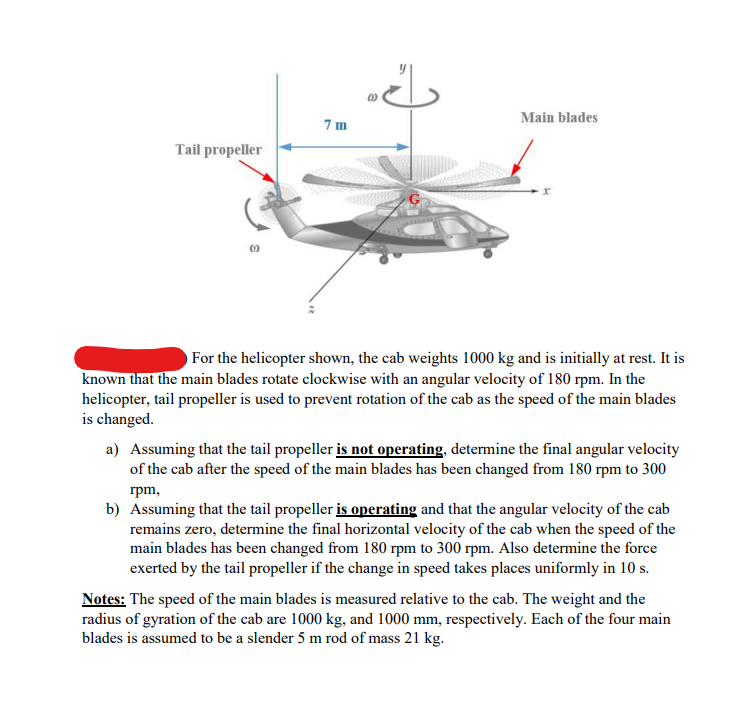For the helicopter shown, the cab weights 1000 kg and is initially at rest. It is known that the main blades rotate clockwise with an angular velocity of 180 rpm. In the helicopter, tail propeller is used to prevent rotation of the cab as the speed of the main blades is changed. a) Assuming that the tail propeller is not operating, determine the final angular velocity of the cab after the speed of the main blades has been changed from 180 rpm to 300 грт, b) Assuming that the tail propeller is operating and that the angular velocity of the cab remains zero, determine the final horizontal velocity of the cab when the speed of the main blades has been changed from 180 rpm to 300 rpm. Also determine the force exerted by the tail propeller if the change in speed takes places uniformly in 10 s. Notes: The speed of the main blades is measured relative to the cab. The weight and the radius of gyration of the cab are 1000 kg, and 1000 mm, respectively. Each of the four main blades is assumed to be a slender 5 m rod of mass 21 kg.
For the helicopter shown, the cab weights 1000 kg and is initially at rest. It is known that the main blades rotate clockwise with an angular velocity of 180 rpm. In the helicopter, tail propeller is used to prevent rotation of the cab as the speed of the main blades is changed. a) Assuming that the tail propeller is not operating, determine the final angular velocity of the cab after the speed of the main blades has been changed from 180 rpm to 300 грт, b) Assuming that the tail propeller is operating and that the angular velocity of the cab remains zero, determine the final horizontal velocity of the cab when the speed of the main blades has been changed from 180 rpm to 300 rpm. Also determine the force exerted by the tail propeller if the change in speed takes places uniformly in 10 s. Notes: The speed of the main blades is measured relative to the cab. The weight and the radius of gyration of the cab are 1000 kg, and 1000 mm, respectively. Each of the four main blades is assumed to be a slender 5 m rod of mass 21 kg.
Elements Of Electromagnetics
7th Edition
ISBN:9780190698614
Author:Sadiku, Matthew N. O.
Publisher:Sadiku, Matthew N. O.
ChapterMA: Math Assessment
Section: Chapter Questions
Problem 1.1MA
Related questions
Question

Transcribed Image Text:Main blades
7 m
Tail propeller
For the helicopter shown, the cab weights 1000 kg and is initially at rest. It is
known that the main blades rotate clockwise with an angular velocity of 180 rpm. In the
helicopter, tail propeller is used to prevent rotation of the cab as the speed of the main blades
is changed.
a) Assuming that the tail propeller is not operating, determine the final angular velocity
of the cab after the speed of the main blades has been changed from 180 rpm to 300
грm,
b) Assuming that the tail propeller is operating and that the angular velocity of the cab
remains zero, determine the final horizontal velocity of the cab when the speed of the
main blades has been changed from 180 rpm to 300 rpm. Also determine the force
exerted by the tail propeller if the change in speed takes places uniformly in 10 s.
Notes: The speed of the main blades is measured relative to the cab. The weight and the
radius of gyration of the cab are 1000 kg, and 1000 mm, respectively. Each of the four main
blades is assumed to be a slender 5 m rod of mass 21 kg.
Expert Solution
This question has been solved!
Explore an expertly crafted, step-by-step solution for a thorough understanding of key concepts.
Step by step
Solved in 3 steps with 3 images

Knowledge Booster
Learn more about
Need a deep-dive on the concept behind this application? Look no further. Learn more about this topic, mechanical-engineering and related others by exploring similar questions and additional content below.Recommended textbooks for you

Elements Of Electromagnetics
Mechanical Engineering
ISBN:
9780190698614
Author:
Sadiku, Matthew N. O.
Publisher:
Oxford University Press

Mechanics of Materials (10th Edition)
Mechanical Engineering
ISBN:
9780134319650
Author:
Russell C. Hibbeler
Publisher:
PEARSON

Thermodynamics: An Engineering Approach
Mechanical Engineering
ISBN:
9781259822674
Author:
Yunus A. Cengel Dr., Michael A. Boles
Publisher:
McGraw-Hill Education

Elements Of Electromagnetics
Mechanical Engineering
ISBN:
9780190698614
Author:
Sadiku, Matthew N. O.
Publisher:
Oxford University Press

Mechanics of Materials (10th Edition)
Mechanical Engineering
ISBN:
9780134319650
Author:
Russell C. Hibbeler
Publisher:
PEARSON

Thermodynamics: An Engineering Approach
Mechanical Engineering
ISBN:
9781259822674
Author:
Yunus A. Cengel Dr., Michael A. Boles
Publisher:
McGraw-Hill Education

Control Systems Engineering
Mechanical Engineering
ISBN:
9781118170519
Author:
Norman S. Nise
Publisher:
WILEY

Mechanics of Materials (MindTap Course List)
Mechanical Engineering
ISBN:
9781337093347
Author:
Barry J. Goodno, James M. Gere
Publisher:
Cengage Learning

Engineering Mechanics: Statics
Mechanical Engineering
ISBN:
9781118807330
Author:
James L. Meriam, L. G. Kraige, J. N. Bolton
Publisher:
WILEY